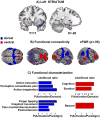Psychosocial versus physiological stress - Meta-analyses on deactivations and activations of the neural correlates of stress reactions
- PMID: 26123376
- PMCID: PMC4564342
- DOI: 10.1016/j.neuroimage.2015.06.059
Psychosocial versus physiological stress - Meta-analyses on deactivations and activations of the neural correlates of stress reactions
Abstract
Stress is present in everyday life in various forms and situations. Two stressors frequently investigated are physiological and psychosocial stress. Besides similar subjective and hormonal responses, it has been suggested that they also share common neural substrates. The current study used activation-likelihood-estimation meta-analysis to test this assumption by integrating results of previous neuroimaging studies on stress processing. Reported results are cluster-level FWE corrected. The inferior frontal gyrus (IFG) and the anterior insula (AI) were the only regions that demonstrated overlapping activation for both stressors. Analysis of physiological stress showed consistent activation of cognitive and affective components of pain processing such as the insula, striatum, or the middle cingulate cortex. Contrarily, analysis across psychosocial stress revealed consistent activation of the right superior temporal gyrus and deactivation of the striatum. Notably, parts of the striatum appeared to be functionally specified: the dorsal striatum was activated in physiological stress, whereas the ventral striatum was deactivated in psychosocial stress. Additional functional connectivity and decoding analyses further characterized this functional heterogeneity and revealed higher associations of the dorsal striatum with motor regions and of the ventral striatum with reward processing. Based on our meta-analytic approach, activation of the IFG and the AI seems to indicate a global neural stress reaction. While physiological stress activates a motoric fight-or-flight reaction, during psychosocial stress attention is shifted towards emotion regulation and goal-directed behavior, and reward processing is reduced. Our results show the significance of differentiating physiological and psychosocial stress in neural engagement. Furthermore, the assessment of deactivations in addition to activations in stress research is highly recommended.
Keywords: Achievement stress; IFG; Insula; Pain; Social exclusion; Striatum.
Copyright © 2015 Elsevier Inc. All rights reserved.
Conflict of interest statement
All authors declare no conflict of interest in relation to the manuscript.
Figures




References
-
- Adler CM, Elman I, Weisenfeld N, Kestler L, Pickar D, Breier A. Effects of Acute Metabolic Stress on Striatal Dopamine Release in Healthy Volunteers. Neuropsychopharmacology. 2000;22:545–550. - PubMed
-
- Admon R, Leykin D, Lubin G, Engert V, Andrews J, Pruessner J, Hendler T. Stress-induced reduction in hippocampal volume and connectivity with the ventromedial prefrontal cortex are related to maladaptive responses to stressful military service. Hum Brain Mapp. 2013;34:2808–2816. doi: 10.1002/hbm.22100. - DOI - PMC - PubMed
-
- American Psychological Association. Stress in America findings. Washington, D.C.: American Psychological Association; 2010.
-
- Amunts K, Kedo O, Kindler M, Pieperhoff P, Mohlberg H, Shah NJ, Habel U, Schneider F, Zilles K. Cytoarchitectonic mapping of the human amygdala, hippocampal region and entorhinal cortex: intersubject variability and probability maps. Anat Embryol (Berl) 2005;210 - PubMed
Publication types
MeSH terms
Grants and funding
LinkOut - more resources
Full Text Sources
Other Literature Sources
Medical

